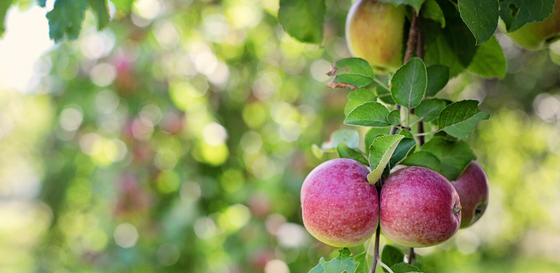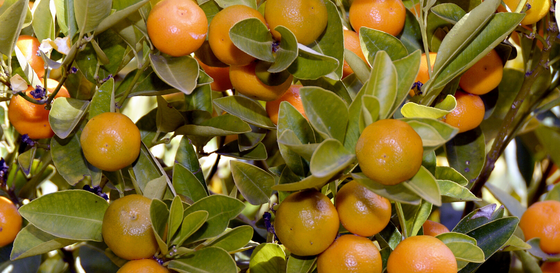
Citrus Fruit Salad Trees are excellent additions to your garden or balcony. They provide leaves year round, plus delicious sweet and tart fruits such as Oranges, Pomelos, Mandarins, Limes, Tangelo, Lemon and Lemonade and Grapefruit. When citrus leaves start to curl, it can be upsetting, but a little care can remedy the pest or environmental problem. Here's a full rundown on what is causing the leaves to curl and what to do about it, so that you can ensure your Fruit Salad Tree can continue to bear a bountiful harvest.
Citrus trees exposed to wind will grow slower than those protected from strong wind. Leaves and fruit can be damage when rubbed against thorns, dead twigs and branches due to the wind. Symptoms of wind injury include misshapen and puckered leaves and the fruit will have irregular brown marks on the rind.
Prolonged heat and little to no water is the most common cause of leaves curling. If the leaves are still green, but curling inward, it is a sign of drought stress. If the soil at the base of the tree is dry, then you need to increase watering and add up to 10cm of organic mulch to the base of the tree to keep the moisture in. Don't place the mulch too close to the trunk of the tree.
Try to 'deep water' your tree by leaving the hose on a trickle overnight so that the water can penetrate and nourish the depths of the root system. Read more about watering your Fruit Salad Tree here.

Sap-sucking pests like aphids and mites feed on the juice of the leaves. As their populations grow, they cause deformations including curling, cupping and discolouration. Read more about aphids and citrus trees here.
Treat aphids and mites with Neem oil in the cooler part of the day. Repeat weekly until the pests disappear from the tree.

Citrus leaf miners leave a trail on the leaves. They don't suck the sap like aphids and mites. Instead, they tunnel through leaf tissues as they grow.
It is best to remove the infected leaves and place in the bin to stop the leaf miners moving on to other areas of the garden. You can also spray with Dipel, an organic treatment.
Most citrus trees can tolerate leaf miners to an extent, and they are generally tricky to get rid of, so stay patient and keep up the treatments.
When the leaves are slightly yellow and bent at the tip, it can mean that the tree is not receiving enough potassium. Check your soil pH levels and nutrients before treating. If nutrients are low, check with your local nursery for an appropriate fertiliser.
Fertilise your tree at least twice a year, in late Winter and late Summer. Older manure is better than younger manure. Your compost is also a great fertilizer. You can also try mixing a slow release fertiliser like Osmocote into the soil or Blood and Bone or Dynamic Lifter. But, limit to only one of two of these fertilizers each application.
When using fertilizers, keep them away from the trunk of the tree, and top up the mulch when required.
And that's it! Happy harvesting your beautiful citrus Fruit Salad tree!
Did you know that you can also train your tree to grow and spread its branches by using stakes and ties. Read more about espaliering here and also training your Fruit Salad Tree here.
Remove the rootstock (anything that’s not a fruit graft), balance your tree and remember to thin the first fruit.
Here at Fruit Salad Trees, we stock a wide range of fruit trees, which all boast different fruit on the same tree. Each fruit variety retains its own flavour, appearance and ripening time. We graft citrus, stone fruit and multi-apple trees.
Our fast fruiting trees can be grown in the ground, or in pots on your balcony.
Shop our wide range of trees now and check out our current specials here!
For more information caring for your fruit trees, check out the Department of Primary Industries articles on fruit trees.
Read more about leaf curl at Gardening Know How: Curled Leaves On Citrus Plant: What To Do For Curling Citrus
Comments will be approved before showing up.

How does your edible garden grow? Whether it's a balcony garden, a backyard oasis or an extensive orchard, there are a number of items that will help you grow your delicious, fresh kitchen ingredients. Growing a multi-grafted fruit tree isn't as simple as sticking your tree in some dirt and walking away, but they are pretty easy to grow!

Here are some tips to help you keep your Fruit Salad Tree at it's best throughout the year. We all get busy and sometimes the garden jobs get forgotten. We get it!
We've popped these tips and tricks into categories (eg Citrus or Apple or Stonefruit) and then into seasons (eg in autumn remember to do this or keep an eye out for this in summer, etc.) to make things as easy as possible.
Happy, healthy fruit trees grow more fruit and that will make everyone happy!

There are many ways that you can become more sustainable and growing your own beautiful fruit tree at home is a great way to start!
In this short video, Kerry shows her veggie garden and the different types of Fruit Salad Trees to compliment edible gardens big and small.